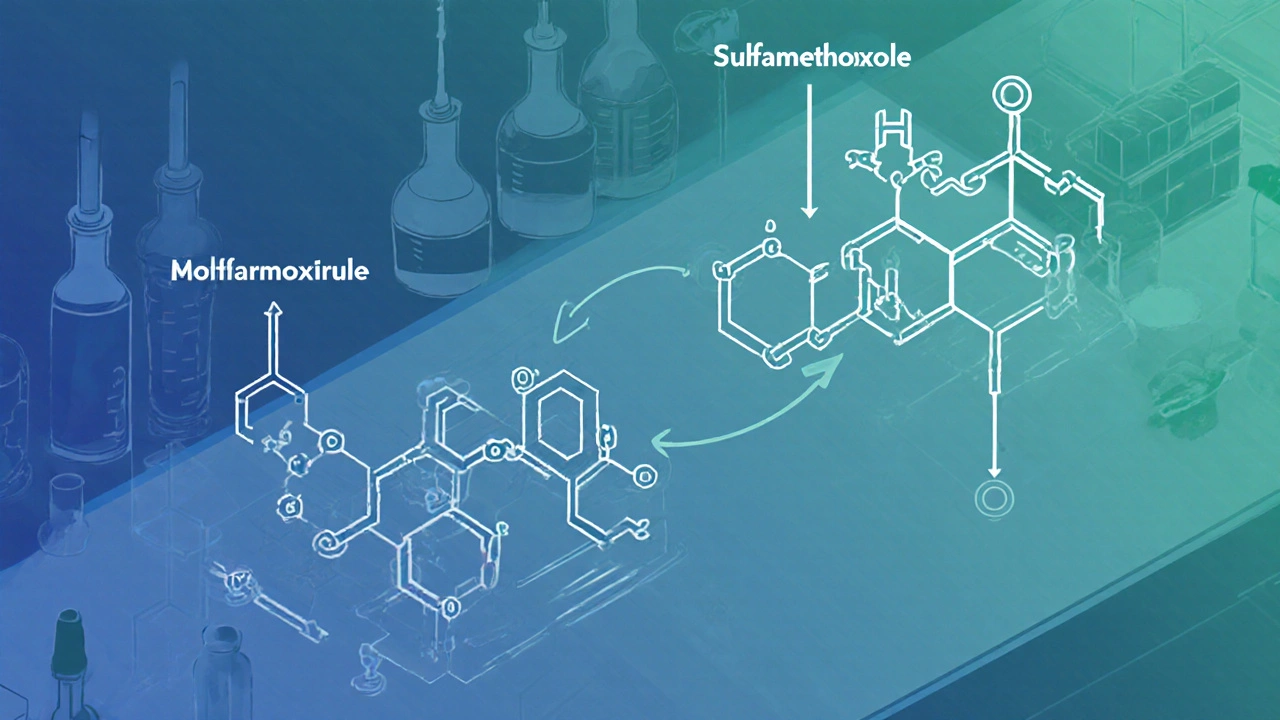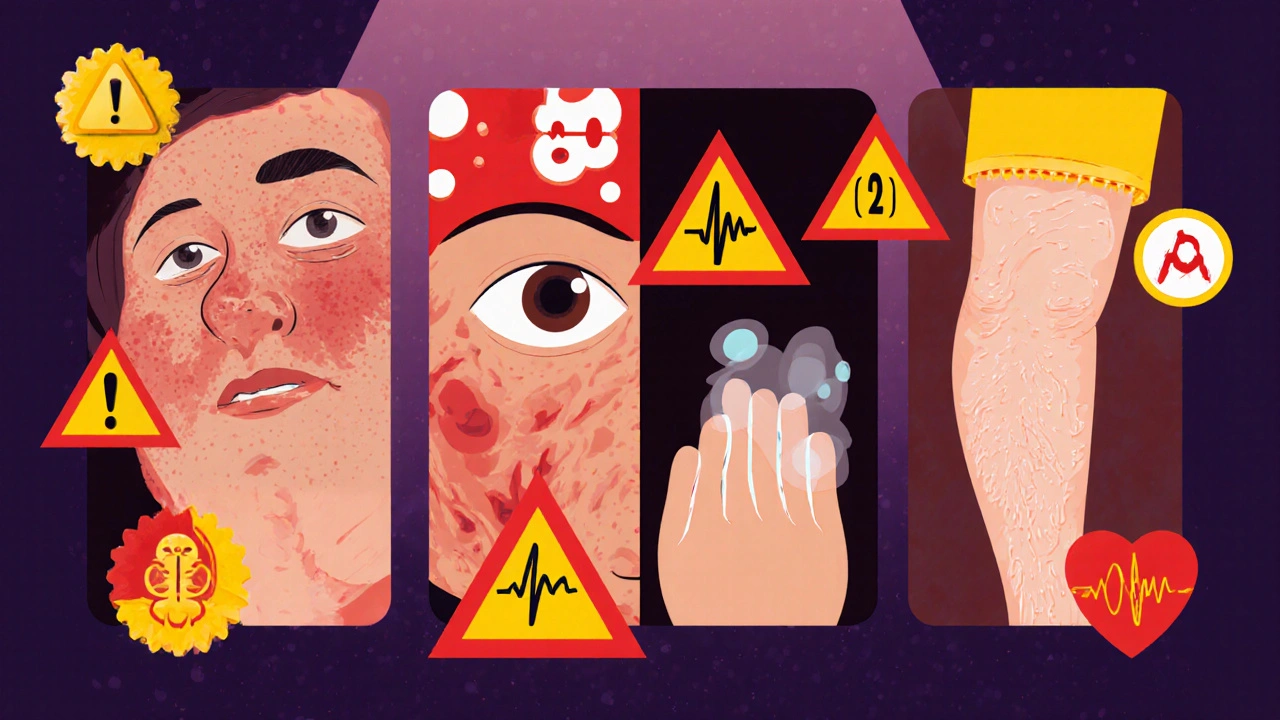Sulfamethoxazole Side Effects: Essential Facts & Risks
 Oct, 19 2025
Oct, 19 2025
Sulfamethoxazole Side Effect Risk Calculator
Personal Risk Assessment
Answer these questions to determine your personalized risk level for sulfamethoxazole side effects.
When you hear the name sulfamethoxazole is a sulfonamide antibiotic often paired with trimethoprim to treat a range of bacterial infections. It’s effective, but like any drug it can bring unwanted reactions. Knowing what to expect helps you spot problems early and talk to your doctor before they become serious.
Why sulfamethoxazole is prescribed
Doctors choose this medication because it blocks bacterial growth by inhibiting folic acid synthesis. It works especially well for urinary‑tract infections, bronchitis, and certain types of pneumonia. When combined with trimethoprim (a dihydrofolate reductase inhibitor) the duo, known as co‑trimoxazole, covers a broader spectrum of bugs.
Common side effects you’ll likely notice
Most people feel fine, but roughly 1 in 10 report mild issues. Typical complaints include:
- Nausea or mild stomach upset
- Headache that fades after a few days
- Skin rash that looks like tiny red spots
- Transient loss of appetite
These usually start within the first few days and disappear without treatment. If they linger, a quick call to your clinician can prevent escalation.
Rare but serious reactions to watch for
Even though they’re uncommon, some side effects demand immediate attention. Keep an eye out for:
- Severe skin blistering or peeling (possible Stevens‑Johnson syndrome)
- Yellowing of the eyes or dark urine (signs of liver toxicity)
- Reduced urine output, swelling in the legs, or sudden weight gain (potential kidney injury)
- High fever, sore throat, and a rapid heart rate (could indicate a severe hypersensitivity reaction)
If any of these appear, stop the medication and seek emergency care.
Understanding the underlying mechanisms
Why do these reactions happen? Sulfonamides can trigger immune responses in susceptible people. The drug’s structure mimics folate, leading the body to produce antibodies that mistakenly attack its own tissues. This is why skin and organ reactions are possible, especially in patients with a history of drug allergies.

Risk factors that increase the chance of adverse effects
Not everyone is equally vulnerable. The following groups need extra caution:
- Patients with a known sulfonamide allergy - prior rash or hives raise the odds of a repeat reaction.
- Those with impaired liver or kidney function - the drug stays longer in the system, raising toxicity risk.
- Pregnant or breastfeeding women - sulfamethoxazole can cross the placenta and appear in breast milk, potentially affecting the baby.
- Elderly individuals - age‑related organ decline can heighten side‑effect severity.
- People taking certain other medications (e.g., warfarin, phenytoin) - drug‑drug interactions may amplify toxicity.
Drug interactions you shouldn’t ignore
Because sulfamethoxazole is metabolized by the liver, it can clash with other substances that use the same pathway. Notable interactions include:
| Medication | Interaction | Potential Outcome |
|---|---|---|
| Warfarin | Increased anticoagulant effect | Higher bleeding risk |
| Phenytoin | Reduced phenytoin clearance | Possible toxicity |
| Oral contraceptives | Altered hormone levels | Decreased contraceptive reliability |
Always share your full medication list with your healthcare provider before starting sulfamethoxazole.
Managing side effects when they occur
If you develop mild nausea, try taking the dose with food or a glass of milk. For skin rashes, over‑the‑counter antihistamines can provide relief, but stop the antibiotic if the rash spreads or becomes painful. Monitoring liver enzymes and kidney function through blood tests is standard practice for long‑term or high‑dose therapy.

Special considerations for specific populations
Pregnancy: Sulfamethoxazole is generally avoided in the first trimester because of a theoretical risk of birth defects. In later stages, doctors weigh the infection risk against potential fetal exposure.
Pediatrics: Children receive weight‑based dosing (often 10‑20 mg/kg of the sulfamethoxazole component). Younger kids are more prone to rash, so close follow‑up is essential.
Elderly: Starting with a lower dose and extending intervals can reduce the chance of kidney injury.
When to seek medical help
Any of the following warrants a call to your doctor or a visit to urgent care:
- Fever above 101 °F (38.3 °C) combined with a rash
- Persistent vomiting or diarrhea lasting more than two days
- Yellowing of skin or eyes
- Sudden swelling of the hands, feet, or face
- Unexplained bruising or bleeding
Prompt action can prevent complications and may save your life.
Key takeaways
- Sulfamethoxazole is an effective sulfonamide antibiotic often paired with trimethoprim.
- Common side effects are mild and short‑lived; serious reactions are rare but require immediate attention.
- Allergy history, organ function, pregnancy, and other medications shape your risk level.
- Regular monitoring and open communication with your healthcare team are the best defenses.
Can I take sulfamethoxazole if I’m allergic to penicillin?
Penicillin allergy does not automatically mean you’ll react to sulfonamides. However, if you’ve ever had a rash or hives from any sulfa drug, avoid sulfamethoxazole or discuss an alternative with your doctor.
How long do side effects usually last?
Mild symptoms like nausea or headache typically improve within 3‑5 days. If they persist beyond a week, contact your clinician.
Is it safe to drink alcohol while on sulfamethoxazole?
Alcohol can increase the risk of liver irritation, especially if you already have liver concerns. Moderate consumption is generally acceptable, but avoid heavy drinking.
What should I do if I miss a dose?
Take the missed dose as soon as you remember, unless it’s almost time for the next one. In that case, skip the missed dose-don’t double up.
Can sulfamethoxazole cause birth defects?
Early‑trimester exposure has been linked to a slightly higher risk of neural‑tube defects. Doctors usually choose another antibiotic for pregnant patients unless the infection is severe.
James Dean
October 19, 2025 AT 22:26Sulfamethoxazole fights bacteria by stealing their folic acid supply it reminds me of how we sometimes have to cut off resources to keep systems in check the side effects are just the inevitable shadows of any powerful tool
Penny Reeves
October 20, 2025 AT 03:26While the article accurately lists the pharmacodynamics, it fails to contextualize the epidemiological data that underpins the risk stratification. A more rigorous meta‑analysis would reveal that the incidence of Stevens‑Johnson syndrome, albeit rare, is statistically significant in certain ethnic cohorts. Moreover, the discussion of drug interactions skirts around the cytochrome‑P450 inhibition pathway which is, frankly, a glaring omission. In short, the piece reads like a watered‑down patient brochure rather than a scholarly review.
Sunil Yathakula
October 20, 2025 AT 09:00Hey friend I totally get how scary it can feel when you see a rash pop up after starting a new med you’re not alone in this and many folks have been there before. If you notice mild nausea or a headache try taking the dose with a little food or even a glass of milk it often helps. And if the skin starts itching just grab an OTC antihistamine but make sure to call your doc if it spreads or gets painful – better safe than sorry. Stay strong, we’re all rooting for your quick recovery.
Catherine Viola
October 20, 2025 AT 14:33One must acknowledge that pharmaceutical conglomerates possess an almost unfettered capacity to obfuscate adverse event data under the guise of regulatory compliance. The systemic suppression of post‑market surveillance findings is not merely negligent; it borders on covert manipulation of public health narratives. Consequently, a prudent individual should demand transparent disclosure of all Phase IV trial outcomes before entrusting their physiology to such a compound.
sravya rudraraju
October 20, 2025 AT 20:06In clinical practice, sulfamethoxazole‑trimethoprim remains a cornerstone therapy for a spectrum of bacterial infections, yet its pharmacologic profile warrants a meticulous appraisal of risk versus benefit. The drug exerts its bacteriostatic effect by impeding folic acid synthesis, a pathway indispensable for microbial nucleic acid production, thereby curtailing pathogen proliferation. However, the same mechanistic interference can precipitate off‑target immunologic phenomena in susceptible hosts, manifesting as cutaneous eruptions or even systemic hypersensitivity syndromes. Epidemiological surveys have delineated that approximately ten percent of patients experience mild adverse effects such as nausea, transient headache, or a fleeting loss of appetite. While these manifestations are generally self‑limiting, they should nevertheless be documented to facilitate ongoing pharmacovigilance. More gravely, rare but severe complications-including Stevens‑Johnson syndrome, drug‑induced hepatitis, and acute interstitial nephritis-have been reported and demand immediate medical intervention. The pathogenesis of such severe reactions is hypothesized to involve haptenization of host proteins, eliciting a misguided immune response that targets epidermal and organ tissues. Patients with a documented sulfonamide hypersensitivity, pre‑existing hepatic or renal insufficiency, or those concomitantly receiving warfarin or phenytoin constitute high‑risk cohorts. In pregnant individuals, particularly during the first trimester, the teratogenic potential of sulfamethoxazole necessitates a judicious risk assessment, often prompting clinicians to consider alternative agents. Pediatric populations also merit special consideration; the incidence of dermatologic reactions is comparatively higher, underscoring the need for vigilant follow‑up. Therapeutic drug monitoring, though not universally mandated, can be advantageous in prolonged courses or in patients with compromised renal clearance to preempt toxicity. Patient education remains paramount: informing individuals to ingest the medication with meals or milk can ameliorate gastrointestinal discomfort, while early recognition of rash or jaundice should trigger prompt medical review. Moreover, clinicians should maintain an up‑to‑date medication reconciliation to identify potential pharmacokinetic interactions that may amplify adverse outcomes. Ultimately, a collaborative approach-integrating physician oversight, patient awareness, and systematic monitoring-optimizes therapeutic efficacy while mitigating the inherent risks associated with sulfamethoxazole‑trimethoprim therapy.
ashanti barrett
October 21, 2025 AT 01:40Given the thorough overview, it is imperative that clinicians implement a standardized checklist prior to prescribing sulfamethoxazole‑trimethoprim. This checklist should include verification of sulfa allergies, assessment of liver and kidney function, and a review of concomitant medications that influence CYP450 metabolism. By institutionalizing such protocols, we can substantially reduce the incidence of severe adverse events and ensure timely intervention when early warning signs arise.
Leo Chan
October 21, 2025 AT 07:13Absolutely agree! Let’s also encourage patients to keep a daily symptom diary during the first week of therapy; that simple habit often catches subtle side effects before they snowball. Sharing these logs with the healthcare team can facilitate rapid adjustments and reinforce a proactive care model.
jagdish soni
October 21, 2025 AT 12:46While your skepticism towards corporate motives is noted, one must also recognize that the rigorous FDA approval process imposes stringent safety benchmarks, thereby providing a modicum of assurance regarding the drug’s risk profile.
Latasha Becker
October 21, 2025 AT 18:20The pharmacokinetic interplay between sulfamethoxazole and cytochrome P450 isoenzymes, particularly CYP2C9, engenders a complex competitive inhibition paradigm that can precipitate supratherapeutic plasma concentrations of concomitant anticoagulants, thereby augmenting hemorrhagic proclivity.
parth gajjar
October 21, 2025 AT 23:53The shadow of such enzymatic antagonism looms large over the therapeutic window, casting doubt on the prudence of unchecked polypharmacy in vulnerable cohorts.
Maridel Frey
October 22, 2025 AT 05:26Consequently, it is advisable to schedule periodic INR assessments when co‑administering warfarin with sulfamethoxazole, adjusting dosing parameters in accordance with observed coagulation metrics to safeguard patient safety.
Madhav Dasari
October 22, 2025 AT 11:00Man, if you ever feel like your skin’s turning into a fireworks show after taking meds, that’s a red flag – don’t wait, hit up the ER ASAP.
DHARMENDER BHATHAVAR
October 22, 2025 AT 16:33Monitoring liver enzymes is essential during prolonged therapy.